Quran: Language and Structure Theory 2022
VerifiedAdded on 2022/09/06
|9
|3067
|25
AI Summary
Contribute Materials
Your contribution can guide someone’s learning journey. Share your
documents today.
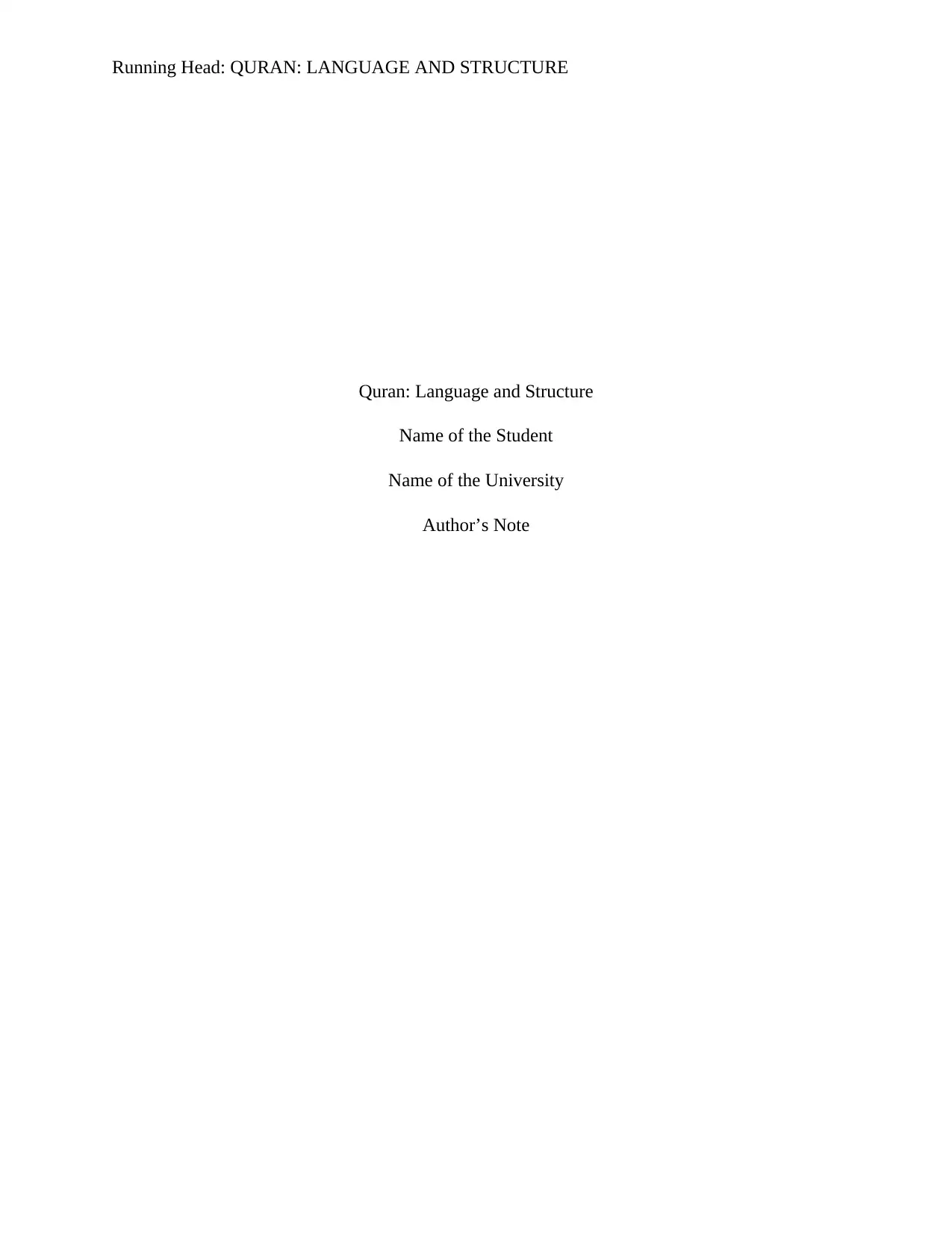
Running Head: QURAN: LANGUAGE AND STRUCTURE
Quran: Language and Structure
Name of the Student
Name of the University
Author’s Note
Quran: Language and Structure
Name of the Student
Name of the University
Author’s Note
Secure Best Marks with AI Grader
Need help grading? Try our AI Grader for instant feedback on your assignments.
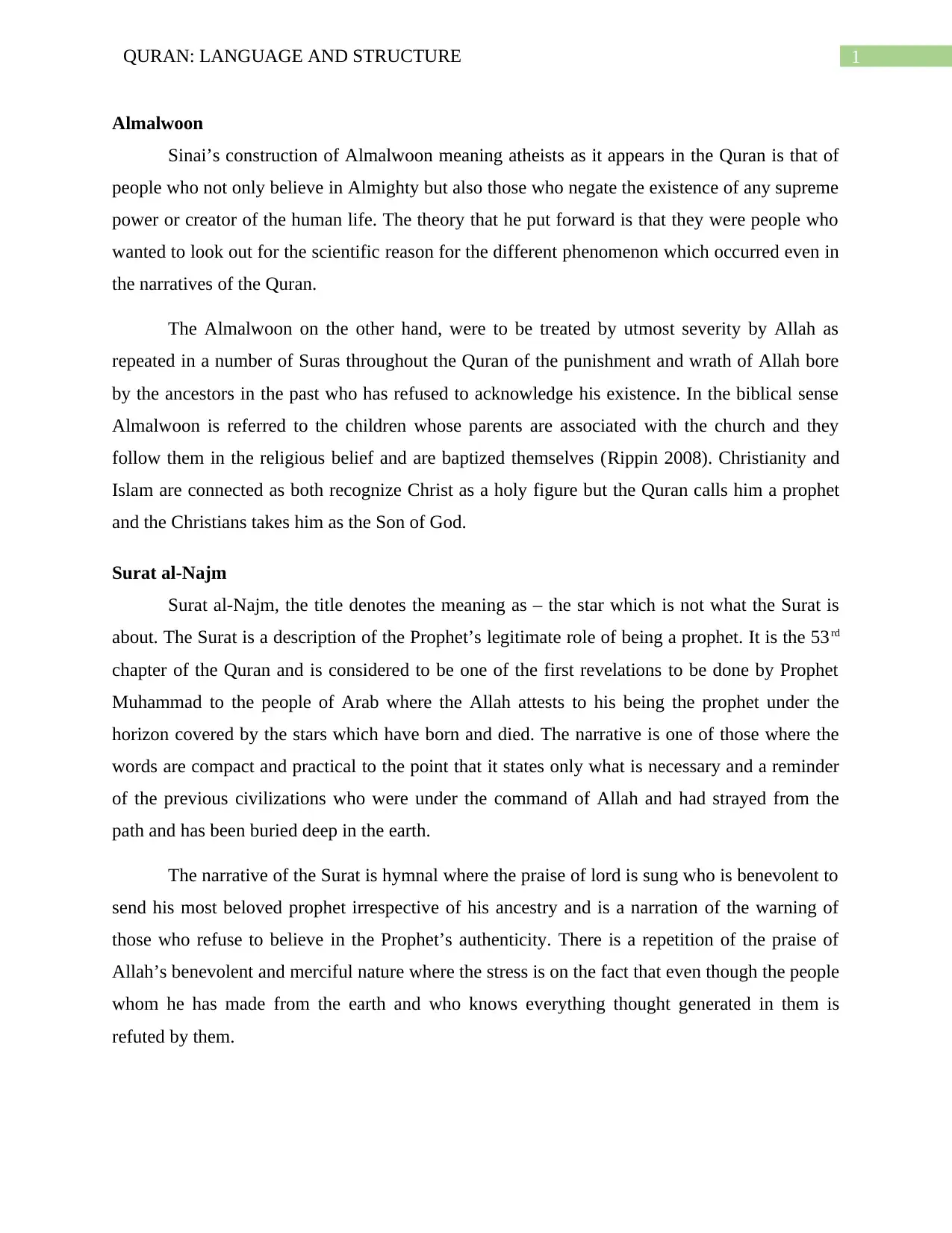
1QURAN: LANGUAGE AND STRUCTURE
Almalwoon
Sinai’s construction of Almalwoon meaning atheists as it appears in the Quran is that of
people who not only believe in Almighty but also those who negate the existence of any supreme
power or creator of the human life. The theory that he put forward is that they were people who
wanted to look out for the scientific reason for the different phenomenon which occurred even in
the narratives of the Quran.
The Almalwoon on the other hand, were to be treated by utmost severity by Allah as
repeated in a number of Suras throughout the Quran of the punishment and wrath of Allah bore
by the ancestors in the past who has refused to acknowledge his existence. In the biblical sense
Almalwoon is referred to the children whose parents are associated with the church and they
follow them in the religious belief and are baptized themselves (Rippin 2008). Christianity and
Islam are connected as both recognize Christ as a holy figure but the Quran calls him a prophet
and the Christians takes him as the Son of God.
Surat al-Najm
Surat al-Najm, the title denotes the meaning as – the star which is not what the Surat is
about. The Surat is a description of the Prophet’s legitimate role of being a prophet. It is the 53rd
chapter of the Quran and is considered to be one of the first revelations to be done by Prophet
Muhammad to the people of Arab where the Allah attests to his being the prophet under the
horizon covered by the stars which have born and died. The narrative is one of those where the
words are compact and practical to the point that it states only what is necessary and a reminder
of the previous civilizations who were under the command of Allah and had strayed from the
path and has been buried deep in the earth.
The narrative of the Surat is hymnal where the praise of lord is sung who is benevolent to
send his most beloved prophet irrespective of his ancestry and is a narration of the warning of
those who refuse to believe in the Prophet’s authenticity. There is a repetition of the praise of
Allah’s benevolent and merciful nature where the stress is on the fact that even though the people
whom he has made from the earth and who knows everything thought generated in them is
refuted by them.
Almalwoon
Sinai’s construction of Almalwoon meaning atheists as it appears in the Quran is that of
people who not only believe in Almighty but also those who negate the existence of any supreme
power or creator of the human life. The theory that he put forward is that they were people who
wanted to look out for the scientific reason for the different phenomenon which occurred even in
the narratives of the Quran.
The Almalwoon on the other hand, were to be treated by utmost severity by Allah as
repeated in a number of Suras throughout the Quran of the punishment and wrath of Allah bore
by the ancestors in the past who has refused to acknowledge his existence. In the biblical sense
Almalwoon is referred to the children whose parents are associated with the church and they
follow them in the religious belief and are baptized themselves (Rippin 2008). Christianity and
Islam are connected as both recognize Christ as a holy figure but the Quran calls him a prophet
and the Christians takes him as the Son of God.
Surat al-Najm
Surat al-Najm, the title denotes the meaning as – the star which is not what the Surat is
about. The Surat is a description of the Prophet’s legitimate role of being a prophet. It is the 53rd
chapter of the Quran and is considered to be one of the first revelations to be done by Prophet
Muhammad to the people of Arab where the Allah attests to his being the prophet under the
horizon covered by the stars which have born and died. The narrative is one of those where the
words are compact and practical to the point that it states only what is necessary and a reminder
of the previous civilizations who were under the command of Allah and had strayed from the
path and has been buried deep in the earth.
The narrative of the Surat is hymnal where the praise of lord is sung who is benevolent to
send his most beloved prophet irrespective of his ancestry and is a narration of the warning of
those who refuse to believe in the Prophet’s authenticity. There is a repetition of the praise of
Allah’s benevolent and merciful nature where the stress is on the fact that even though the people
whom he has made from the earth and who knows everything thought generated in them is
refuted by them.
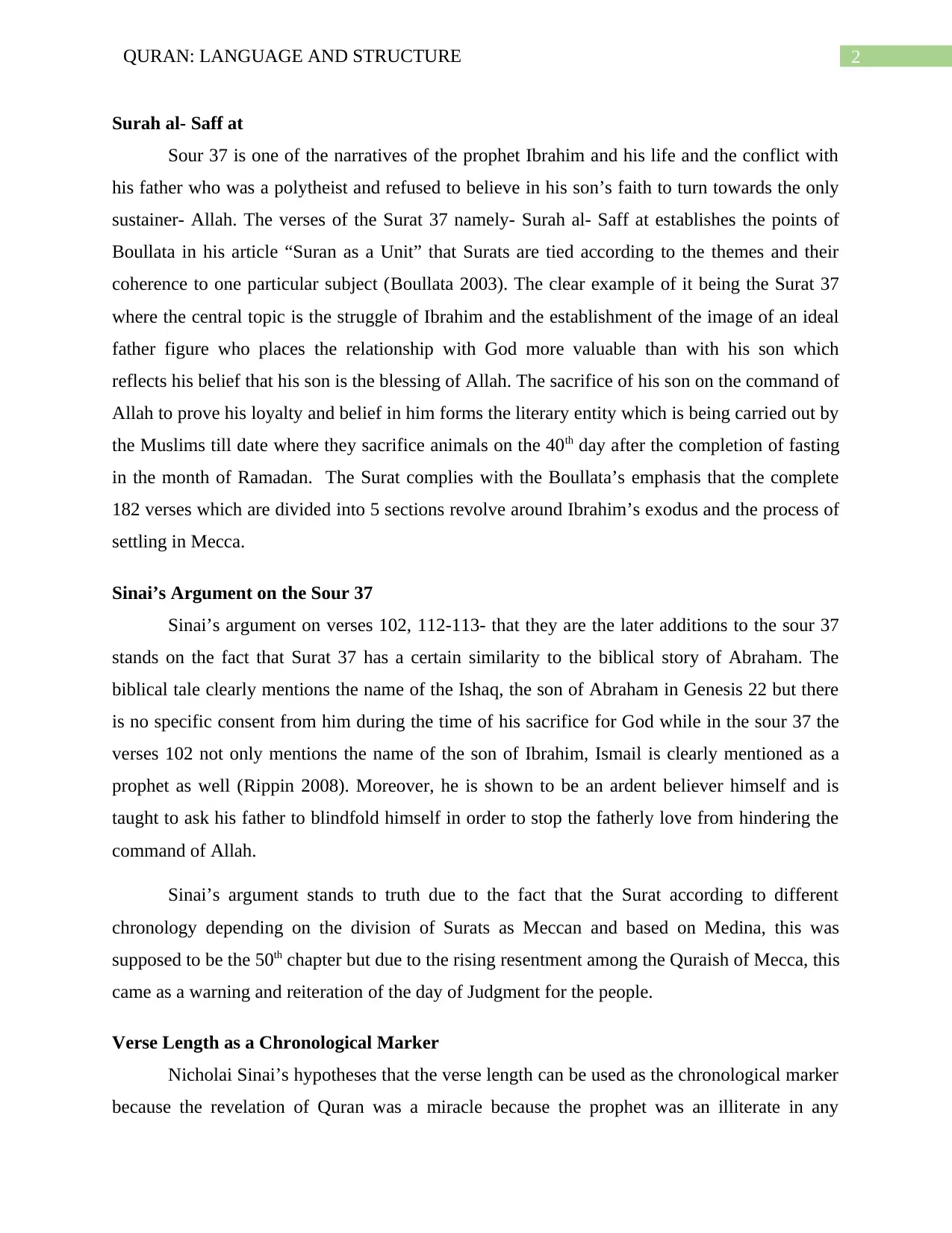
2QURAN: LANGUAGE AND STRUCTURE
Surah al- Saff at
Sour 37 is one of the narratives of the prophet Ibrahim and his life and the conflict with
his father who was a polytheist and refused to believe in his son’s faith to turn towards the only
sustainer- Allah. The verses of the Surat 37 namely- Surah al- Saff at establishes the points of
Boullata in his article “Suran as a Unit” that Surats are tied according to the themes and their
coherence to one particular subject (Boullata 2003). The clear example of it being the Surat 37
where the central topic is the struggle of Ibrahim and the establishment of the image of an ideal
father figure who places the relationship with God more valuable than with his son which
reflects his belief that his son is the blessing of Allah. The sacrifice of his son on the command of
Allah to prove his loyalty and belief in him forms the literary entity which is being carried out by
the Muslims till date where they sacrifice animals on the 40th day after the completion of fasting
in the month of Ramadan. The Surat complies with the Boullata’s emphasis that the complete
182 verses which are divided into 5 sections revolve around Ibrahim’s exodus and the process of
settling in Mecca.
Sinai’s Argument on the Sour 37
Sinai’s argument on verses 102, 112-113- that they are the later additions to the sour 37
stands on the fact that Surat 37 has a certain similarity to the biblical story of Abraham. The
biblical tale clearly mentions the name of the Ishaq, the son of Abraham in Genesis 22 but there
is no specific consent from him during the time of his sacrifice for God while in the sour 37 the
verses 102 not only mentions the name of the son of Ibrahim, Ismail is clearly mentioned as a
prophet as well (Rippin 2008). Moreover, he is shown to be an ardent believer himself and is
taught to ask his father to blindfold himself in order to stop the fatherly love from hindering the
command of Allah.
Sinai’s argument stands to truth due to the fact that the Surat according to different
chronology depending on the division of Surats as Meccan and based on Medina, this was
supposed to be the 50th chapter but due to the rising resentment among the Quraish of Mecca, this
came as a warning and reiteration of the day of Judgment for the people.
Verse Length as a Chronological Marker
Nicholai Sinai’s hypotheses that the verse length can be used as the chronological marker
because the revelation of Quran was a miracle because the prophet was an illiterate in any
Surah al- Saff at
Sour 37 is one of the narratives of the prophet Ibrahim and his life and the conflict with
his father who was a polytheist and refused to believe in his son’s faith to turn towards the only
sustainer- Allah. The verses of the Surat 37 namely- Surah al- Saff at establishes the points of
Boullata in his article “Suran as a Unit” that Surats are tied according to the themes and their
coherence to one particular subject (Boullata 2003). The clear example of it being the Surat 37
where the central topic is the struggle of Ibrahim and the establishment of the image of an ideal
father figure who places the relationship with God more valuable than with his son which
reflects his belief that his son is the blessing of Allah. The sacrifice of his son on the command of
Allah to prove his loyalty and belief in him forms the literary entity which is being carried out by
the Muslims till date where they sacrifice animals on the 40th day after the completion of fasting
in the month of Ramadan. The Surat complies with the Boullata’s emphasis that the complete
182 verses which are divided into 5 sections revolve around Ibrahim’s exodus and the process of
settling in Mecca.
Sinai’s Argument on the Sour 37
Sinai’s argument on verses 102, 112-113- that they are the later additions to the sour 37
stands on the fact that Surat 37 has a certain similarity to the biblical story of Abraham. The
biblical tale clearly mentions the name of the Ishaq, the son of Abraham in Genesis 22 but there
is no specific consent from him during the time of his sacrifice for God while in the sour 37 the
verses 102 not only mentions the name of the son of Ibrahim, Ismail is clearly mentioned as a
prophet as well (Rippin 2008). Moreover, he is shown to be an ardent believer himself and is
taught to ask his father to blindfold himself in order to stop the fatherly love from hindering the
command of Allah.
Sinai’s argument stands to truth due to the fact that the Surat according to different
chronology depending on the division of Surats as Meccan and based on Medina, this was
supposed to be the 50th chapter but due to the rising resentment among the Quraish of Mecca, this
came as a warning and reiteration of the day of Judgment for the people.
Verse Length as a Chronological Marker
Nicholai Sinai’s hypotheses that the verse length can be used as the chronological marker
because the revelation of Quran was a miracle because the prophet was an illiterate in any
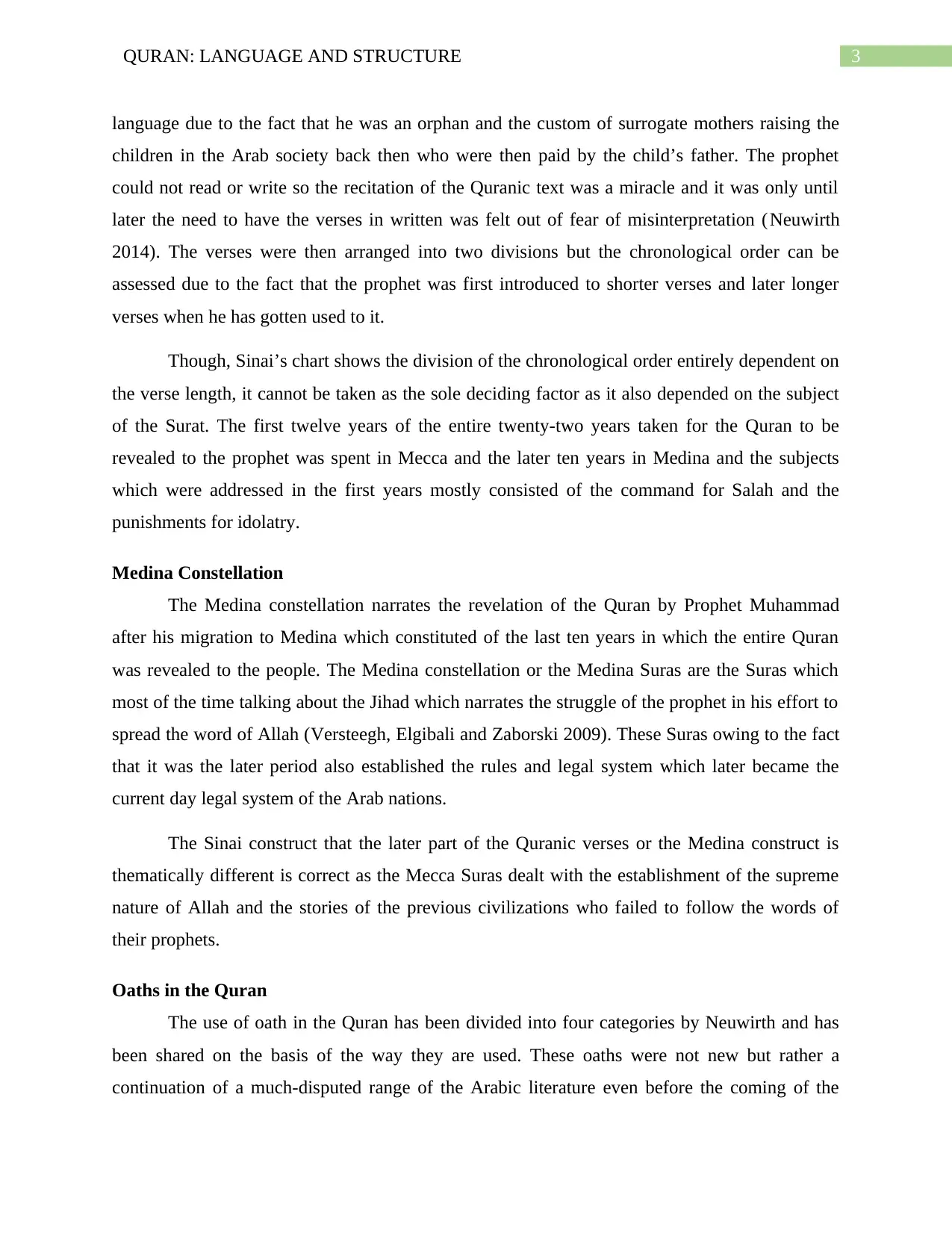
3QURAN: LANGUAGE AND STRUCTURE
language due to the fact that he was an orphan and the custom of surrogate mothers raising the
children in the Arab society back then who were then paid by the child’s father. The prophet
could not read or write so the recitation of the Quranic text was a miracle and it was only until
later the need to have the verses in written was felt out of fear of misinterpretation (Neuwirth
2014). The verses were then arranged into two divisions but the chronological order can be
assessed due to the fact that the prophet was first introduced to shorter verses and later longer
verses when he has gotten used to it.
Though, Sinai’s chart shows the division of the chronological order entirely dependent on
the verse length, it cannot be taken as the sole deciding factor as it also depended on the subject
of the Surat. The first twelve years of the entire twenty-two years taken for the Quran to be
revealed to the prophet was spent in Mecca and the later ten years in Medina and the subjects
which were addressed in the first years mostly consisted of the command for Salah and the
punishments for idolatry.
Medina Constellation
The Medina constellation narrates the revelation of the Quran by Prophet Muhammad
after his migration to Medina which constituted of the last ten years in which the entire Quran
was revealed to the people. The Medina constellation or the Medina Suras are the Suras which
most of the time talking about the Jihad which narrates the struggle of the prophet in his effort to
spread the word of Allah (Versteegh, Elgibali and Zaborski 2009). These Suras owing to the fact
that it was the later period also established the rules and legal system which later became the
current day legal system of the Arab nations.
The Sinai construct that the later part of the Quranic verses or the Medina construct is
thematically different is correct as the Mecca Suras dealt with the establishment of the supreme
nature of Allah and the stories of the previous civilizations who failed to follow the words of
their prophets.
Oaths in the Quran
The use of oath in the Quran has been divided into four categories by Neuwirth and has
been shared on the basis of the way they are used. These oaths were not new but rather a
continuation of a much-disputed range of the Arabic literature even before the coming of the
language due to the fact that he was an orphan and the custom of surrogate mothers raising the
children in the Arab society back then who were then paid by the child’s father. The prophet
could not read or write so the recitation of the Quranic text was a miracle and it was only until
later the need to have the verses in written was felt out of fear of misinterpretation (Neuwirth
2014). The verses were then arranged into two divisions but the chronological order can be
assessed due to the fact that the prophet was first introduced to shorter verses and later longer
verses when he has gotten used to it.
Though, Sinai’s chart shows the division of the chronological order entirely dependent on
the verse length, it cannot be taken as the sole deciding factor as it also depended on the subject
of the Surat. The first twelve years of the entire twenty-two years taken for the Quran to be
revealed to the prophet was spent in Mecca and the later ten years in Medina and the subjects
which were addressed in the first years mostly consisted of the command for Salah and the
punishments for idolatry.
Medina Constellation
The Medina constellation narrates the revelation of the Quran by Prophet Muhammad
after his migration to Medina which constituted of the last ten years in which the entire Quran
was revealed to the people. The Medina constellation or the Medina Suras are the Suras which
most of the time talking about the Jihad which narrates the struggle of the prophet in his effort to
spread the word of Allah (Versteegh, Elgibali and Zaborski 2009). These Suras owing to the fact
that it was the later period also established the rules and legal system which later became the
current day legal system of the Arab nations.
The Sinai construct that the later part of the Quranic verses or the Medina construct is
thematically different is correct as the Mecca Suras dealt with the establishment of the supreme
nature of Allah and the stories of the previous civilizations who failed to follow the words of
their prophets.
Oaths in the Quran
The use of oath in the Quran has been divided into four categories by Neuwirth and has
been shared on the basis of the way they are used. These oaths were not new but rather a
continuation of a much-disputed range of the Arabic literature even before the coming of the
Secure Best Marks with AI Grader
Need help grading? Try our AI Grader for instant feedback on your assignments.
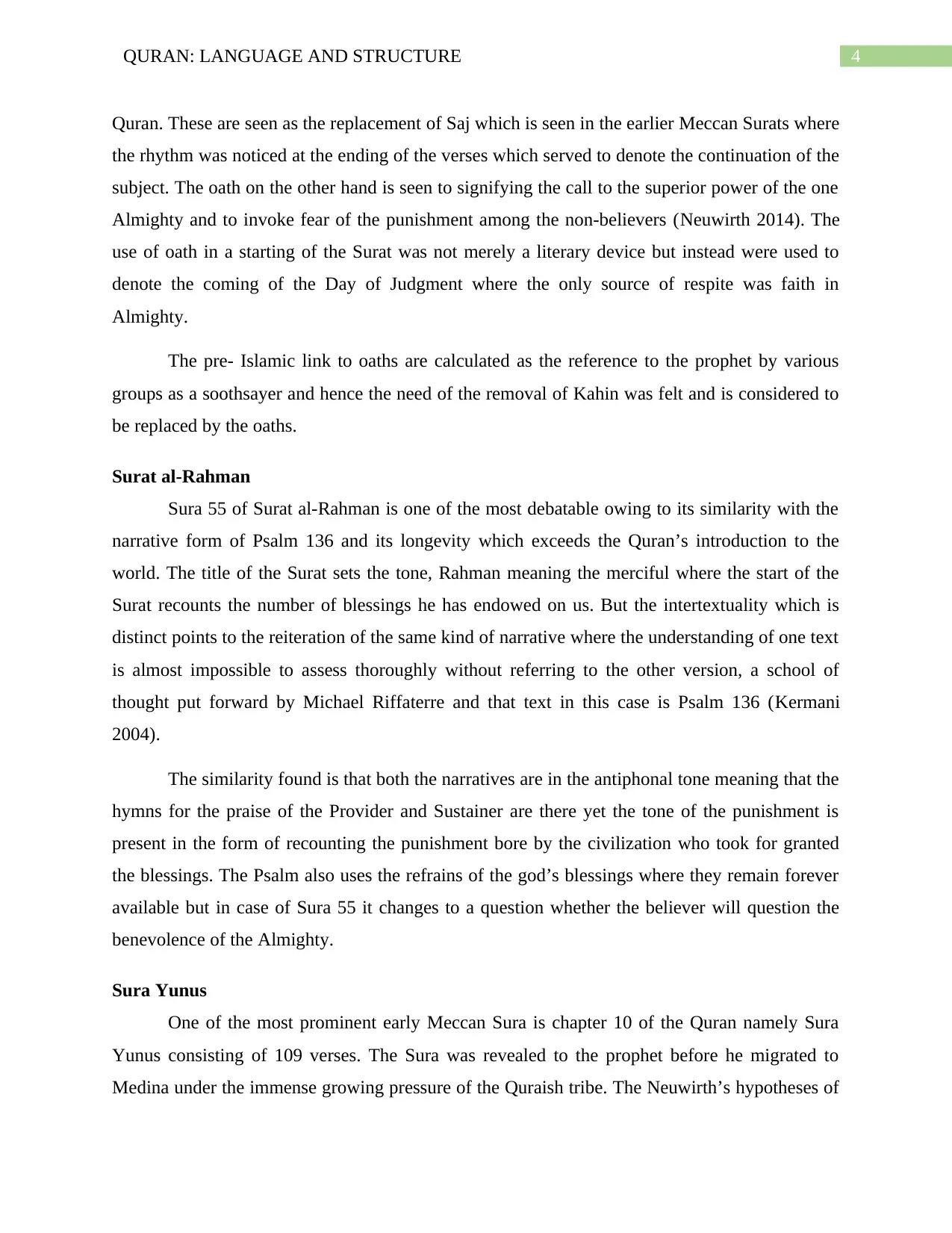
4QURAN: LANGUAGE AND STRUCTURE
Quran. These are seen as the replacement of Saj which is seen in the earlier Meccan Surats where
the rhythm was noticed at the ending of the verses which served to denote the continuation of the
subject. The oath on the other hand is seen to signifying the call to the superior power of the one
Almighty and to invoke fear of the punishment among the non-believers (Neuwirth 2014). The
use of oath in a starting of the Surat was not merely a literary device but instead were used to
denote the coming of the Day of Judgment where the only source of respite was faith in
Almighty.
The pre- Islamic link to oaths are calculated as the reference to the prophet by various
groups as a soothsayer and hence the need of the removal of Kahin was felt and is considered to
be replaced by the oaths.
Surat al-Rahman
Sura 55 of Surat al-Rahman is one of the most debatable owing to its similarity with the
narrative form of Psalm 136 and its longevity which exceeds the Quran’s introduction to the
world. The title of the Surat sets the tone, Rahman meaning the merciful where the start of the
Surat recounts the number of blessings he has endowed on us. But the intertextuality which is
distinct points to the reiteration of the same kind of narrative where the understanding of one text
is almost impossible to assess thoroughly without referring to the other version, a school of
thought put forward by Michael Riffaterre and that text in this case is Psalm 136 (Kermani
2004).
The similarity found is that both the narratives are in the antiphonal tone meaning that the
hymns for the praise of the Provider and Sustainer are there yet the tone of the punishment is
present in the form of recounting the punishment bore by the civilization who took for granted
the blessings. The Psalm also uses the refrains of the god’s blessings where they remain forever
available but in case of Sura 55 it changes to a question whether the believer will question the
benevolence of the Almighty.
Sura Yunus
One of the most prominent early Meccan Sura is chapter 10 of the Quran namely Sura
Yunus consisting of 109 verses. The Sura was revealed to the prophet before he migrated to
Medina under the immense growing pressure of the Quraish tribe. The Neuwirth’s hypotheses of
Quran. These are seen as the replacement of Saj which is seen in the earlier Meccan Surats where
the rhythm was noticed at the ending of the verses which served to denote the continuation of the
subject. The oath on the other hand is seen to signifying the call to the superior power of the one
Almighty and to invoke fear of the punishment among the non-believers (Neuwirth 2014). The
use of oath in a starting of the Surat was not merely a literary device but instead were used to
denote the coming of the Day of Judgment where the only source of respite was faith in
Almighty.
The pre- Islamic link to oaths are calculated as the reference to the prophet by various
groups as a soothsayer and hence the need of the removal of Kahin was felt and is considered to
be replaced by the oaths.
Surat al-Rahman
Sura 55 of Surat al-Rahman is one of the most debatable owing to its similarity with the
narrative form of Psalm 136 and its longevity which exceeds the Quran’s introduction to the
world. The title of the Surat sets the tone, Rahman meaning the merciful where the start of the
Surat recounts the number of blessings he has endowed on us. But the intertextuality which is
distinct points to the reiteration of the same kind of narrative where the understanding of one text
is almost impossible to assess thoroughly without referring to the other version, a school of
thought put forward by Michael Riffaterre and that text in this case is Psalm 136 (Kermani
2004).
The similarity found is that both the narratives are in the antiphonal tone meaning that the
hymns for the praise of the Provider and Sustainer are there yet the tone of the punishment is
present in the form of recounting the punishment bore by the civilization who took for granted
the blessings. The Psalm also uses the refrains of the god’s blessings where they remain forever
available but in case of Sura 55 it changes to a question whether the believer will question the
benevolence of the Almighty.
Sura Yunus
One of the most prominent early Meccan Sura is chapter 10 of the Quran namely Sura
Yunus consisting of 109 verses. The Sura was revealed to the prophet before he migrated to
Medina under the immense growing pressure of the Quraish tribe. The Neuwirth’s hypotheses of
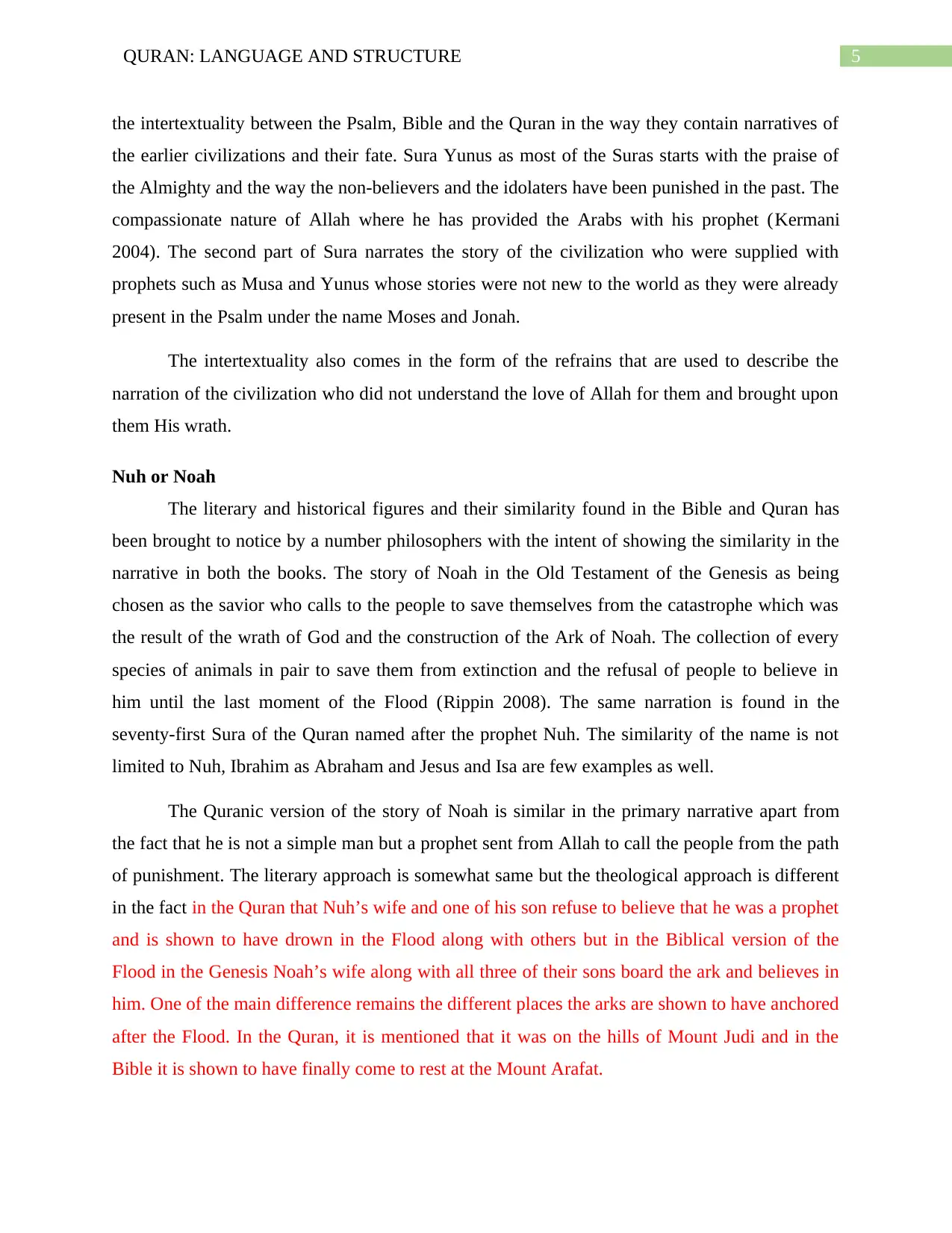
5QURAN: LANGUAGE AND STRUCTURE
the intertextuality between the Psalm, Bible and the Quran in the way they contain narratives of
the earlier civilizations and their fate. Sura Yunus as most of the Suras starts with the praise of
the Almighty and the way the non-believers and the idolaters have been punished in the past. The
compassionate nature of Allah where he has provided the Arabs with his prophet (Kermani
2004). The second part of Sura narrates the story of the civilization who were supplied with
prophets such as Musa and Yunus whose stories were not new to the world as they were already
present in the Psalm under the name Moses and Jonah.
The intertextuality also comes in the form of the refrains that are used to describe the
narration of the civilization who did not understand the love of Allah for them and brought upon
them His wrath.
Nuh or Noah
The literary and historical figures and their similarity found in the Bible and Quran has
been brought to notice by a number philosophers with the intent of showing the similarity in the
narrative in both the books. The story of Noah in the Old Testament of the Genesis as being
chosen as the savior who calls to the people to save themselves from the catastrophe which was
the result of the wrath of God and the construction of the Ark of Noah. The collection of every
species of animals in pair to save them from extinction and the refusal of people to believe in
him until the last moment of the Flood (Rippin 2008). The same narration is found in the
seventy-first Sura of the Quran named after the prophet Nuh. The similarity of the name is not
limited to Nuh, Ibrahim as Abraham and Jesus and Isa are few examples as well.
The Quranic version of the story of Noah is similar in the primary narrative apart from
the fact that he is not a simple man but a prophet sent from Allah to call the people from the path
of punishment. The literary approach is somewhat same but the theological approach is different
in the fact in the Quran that Nuh’s wife and one of his son refuse to believe that he was a prophet
and is shown to have drown in the Flood along with others but in the Biblical version of the
Flood in the Genesis Noah’s wife along with all three of their sons board the ark and believes in
him. One of the main difference remains the different places the arks are shown to have anchored
after the Flood. In the Quran, it is mentioned that it was on the hills of Mount Judi and in the
Bible it is shown to have finally come to rest at the Mount Arafat.
the intertextuality between the Psalm, Bible and the Quran in the way they contain narratives of
the earlier civilizations and their fate. Sura Yunus as most of the Suras starts with the praise of
the Almighty and the way the non-believers and the idolaters have been punished in the past. The
compassionate nature of Allah where he has provided the Arabs with his prophet (Kermani
2004). The second part of Sura narrates the story of the civilization who were supplied with
prophets such as Musa and Yunus whose stories were not new to the world as they were already
present in the Psalm under the name Moses and Jonah.
The intertextuality also comes in the form of the refrains that are used to describe the
narration of the civilization who did not understand the love of Allah for them and brought upon
them His wrath.
Nuh or Noah
The literary and historical figures and their similarity found in the Bible and Quran has
been brought to notice by a number philosophers with the intent of showing the similarity in the
narrative in both the books. The story of Noah in the Old Testament of the Genesis as being
chosen as the savior who calls to the people to save themselves from the catastrophe which was
the result of the wrath of God and the construction of the Ark of Noah. The collection of every
species of animals in pair to save them from extinction and the refusal of people to believe in
him until the last moment of the Flood (Rippin 2008). The same narration is found in the
seventy-first Sura of the Quran named after the prophet Nuh. The similarity of the name is not
limited to Nuh, Ibrahim as Abraham and Jesus and Isa are few examples as well.
The Quranic version of the story of Noah is similar in the primary narrative apart from
the fact that he is not a simple man but a prophet sent from Allah to call the people from the path
of punishment. The literary approach is somewhat same but the theological approach is different
in the fact in the Quran that Nuh’s wife and one of his son refuse to believe that he was a prophet
and is shown to have drown in the Flood along with others but in the Biblical version of the
Flood in the Genesis Noah’s wife along with all three of their sons board the ark and believes in
him. One of the main difference remains the different places the arks are shown to have anchored
after the Flood. In the Quran, it is mentioned that it was on the hills of Mount Judi and in the
Bible it is shown to have finally come to rest at the Mount Arafat.
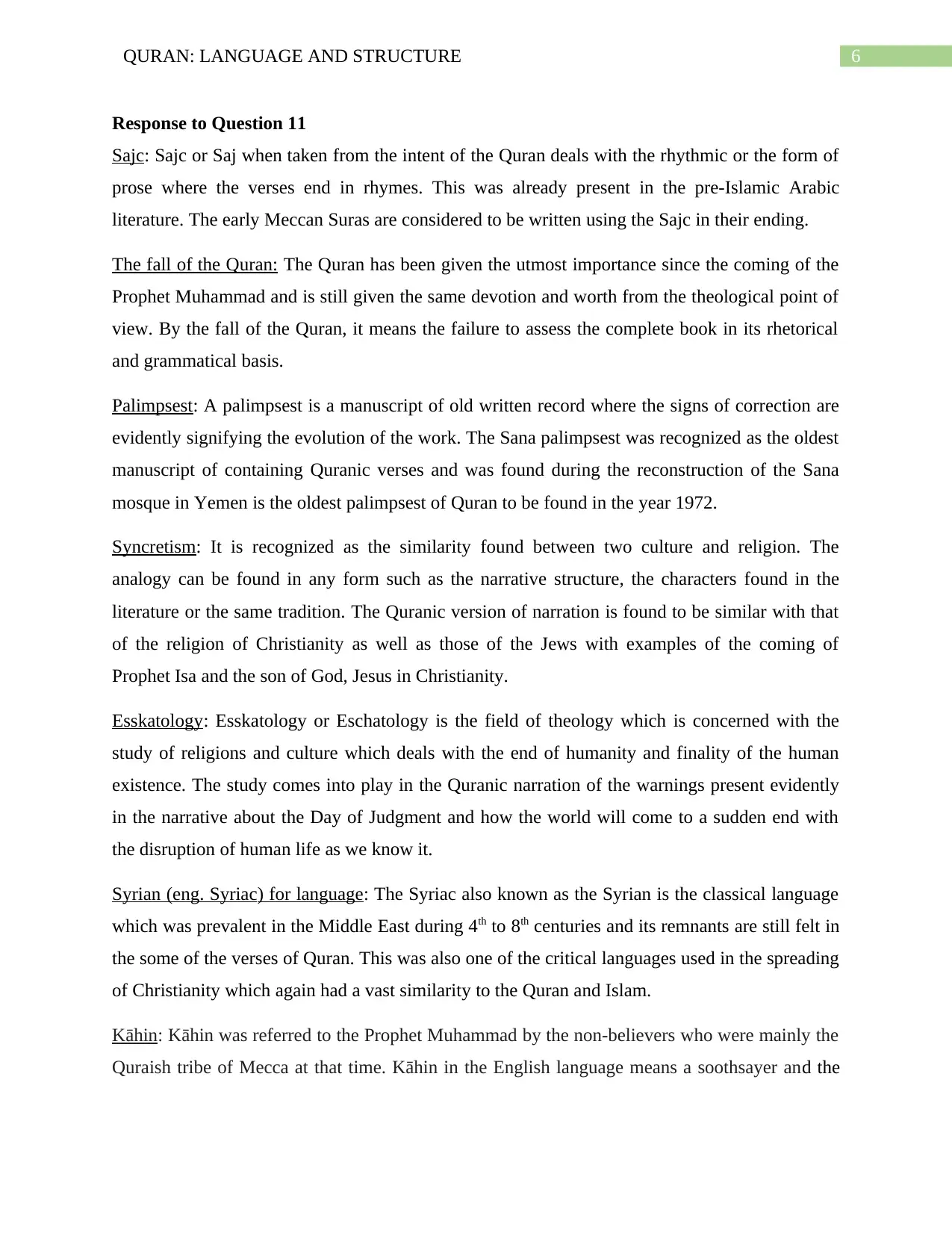
6QURAN: LANGUAGE AND STRUCTURE
Response to Question 11
Sajc: Sajc or Saj when taken from the intent of the Quran deals with the rhythmic or the form of
prose where the verses end in rhymes. This was already present in the pre-Islamic Arabic
literature. The early Meccan Suras are considered to be written using the Sajc in their ending.
The fall of the Quran: The Quran has been given the utmost importance since the coming of the
Prophet Muhammad and is still given the same devotion and worth from the theological point of
view. By the fall of the Quran, it means the failure to assess the complete book in its rhetorical
and grammatical basis.
Palimpsest: A palimpsest is a manuscript of old written record where the signs of correction are
evidently signifying the evolution of the work. The Sana palimpsest was recognized as the oldest
manuscript of containing Quranic verses and was found during the reconstruction of the Sana
mosque in Yemen is the oldest palimpsest of Quran to be found in the year 1972.
Syncretism: It is recognized as the similarity found between two culture and religion. The
analogy can be found in any form such as the narrative structure, the characters found in the
literature or the same tradition. The Quranic version of narration is found to be similar with that
of the religion of Christianity as well as those of the Jews with examples of the coming of
Prophet Isa and the son of God, Jesus in Christianity.
Esskatology: Esskatology or Eschatology is the field of theology which is concerned with the
study of religions and culture which deals with the end of humanity and finality of the human
existence. The study comes into play in the Quranic narration of the warnings present evidently
in the narrative about the Day of Judgment and how the world will come to a sudden end with
the disruption of human life as we know it.
Syrian (eng. Syriac) for language: The Syriac also known as the Syrian is the classical language
which was prevalent in the Middle East during 4th to 8th centuries and its remnants are still felt in
the some of the verses of Quran. This was also one of the critical languages used in the spreading
of Christianity which again had a vast similarity to the Quran and Islam.
Kāhin: Kāhin was referred to the Prophet Muhammad by the non-believers who were mainly the
Quraish tribe of Mecca at that time. Kāhin in the English language means a soothsayer and the
Response to Question 11
Sajc: Sajc or Saj when taken from the intent of the Quran deals with the rhythmic or the form of
prose where the verses end in rhymes. This was already present in the pre-Islamic Arabic
literature. The early Meccan Suras are considered to be written using the Sajc in their ending.
The fall of the Quran: The Quran has been given the utmost importance since the coming of the
Prophet Muhammad and is still given the same devotion and worth from the theological point of
view. By the fall of the Quran, it means the failure to assess the complete book in its rhetorical
and grammatical basis.
Palimpsest: A palimpsest is a manuscript of old written record where the signs of correction are
evidently signifying the evolution of the work. The Sana palimpsest was recognized as the oldest
manuscript of containing Quranic verses and was found during the reconstruction of the Sana
mosque in Yemen is the oldest palimpsest of Quran to be found in the year 1972.
Syncretism: It is recognized as the similarity found between two culture and religion. The
analogy can be found in any form such as the narrative structure, the characters found in the
literature or the same tradition. The Quranic version of narration is found to be similar with that
of the religion of Christianity as well as those of the Jews with examples of the coming of
Prophet Isa and the son of God, Jesus in Christianity.
Esskatology: Esskatology or Eschatology is the field of theology which is concerned with the
study of religions and culture which deals with the end of humanity and finality of the human
existence. The study comes into play in the Quranic narration of the warnings present evidently
in the narrative about the Day of Judgment and how the world will come to a sudden end with
the disruption of human life as we know it.
Syrian (eng. Syriac) for language: The Syriac also known as the Syrian is the classical language
which was prevalent in the Middle East during 4th to 8th centuries and its remnants are still felt in
the some of the verses of Quran. This was also one of the critical languages used in the spreading
of Christianity which again had a vast similarity to the Quran and Islam.
Kāhin: Kāhin was referred to the Prophet Muhammad by the non-believers who were mainly the
Quraish tribe of Mecca at that time. Kāhin in the English language means a soothsayer and the
Paraphrase This Document
Need a fresh take? Get an instant paraphrase of this document with our AI Paraphraser
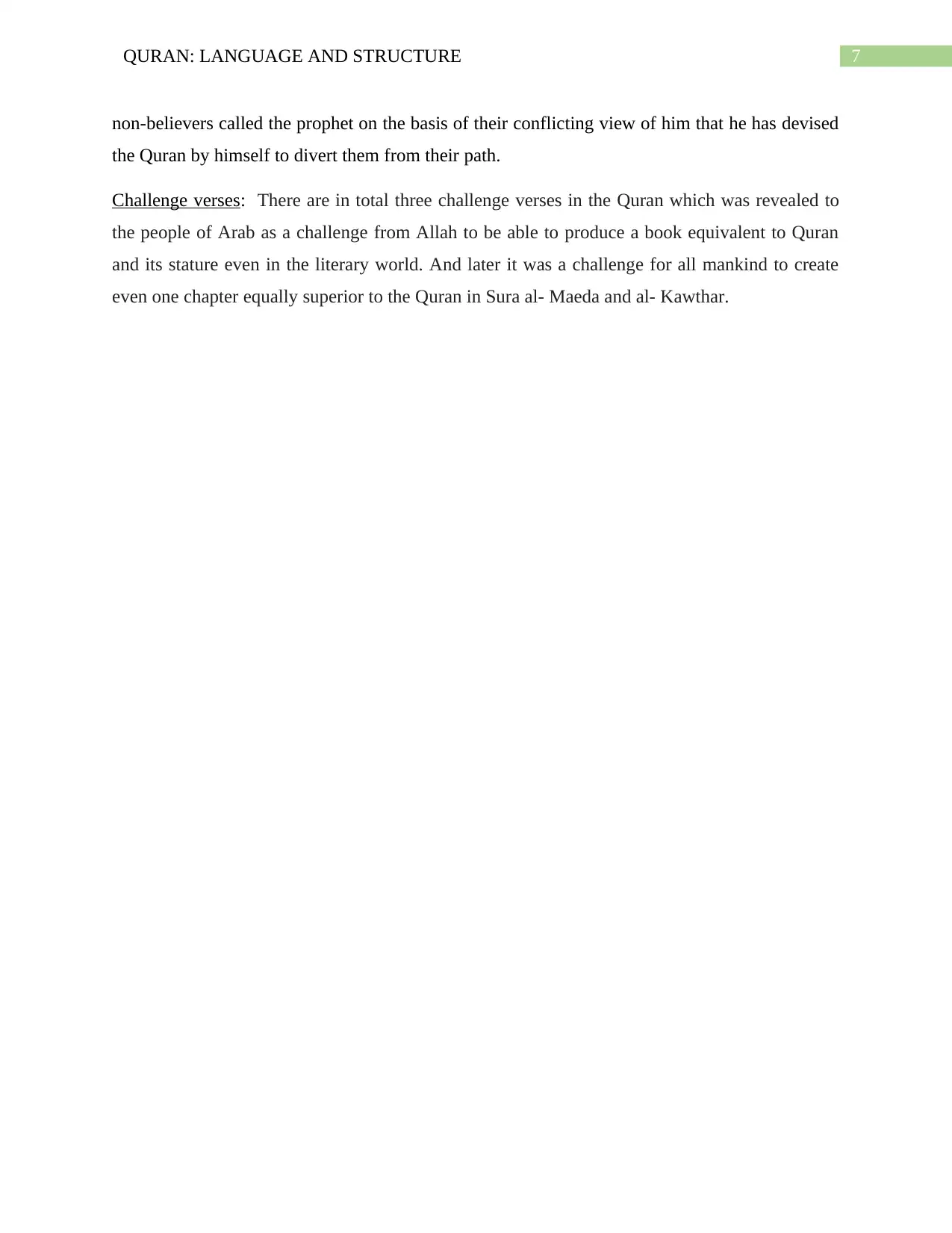
7QURAN: LANGUAGE AND STRUCTURE
non-believers called the prophet on the basis of their conflicting view of him that he has devised
the Quran by himself to divert them from their path.
Challenge verses: There are in total three challenge verses in the Quran which was revealed to
the people of Arab as a challenge from Allah to be able to produce a book equivalent to Quran
and its stature even in the literary world. And later it was a challenge for all mankind to create
even one chapter equally superior to the Quran in Sura al- Maeda and al- Kawthar.
non-believers called the prophet on the basis of their conflicting view of him that he has devised
the Quran by himself to divert them from their path.
Challenge verses: There are in total three challenge verses in the Quran which was revealed to
the people of Arab as a challenge from Allah to be able to produce a book equivalent to Quran
and its stature even in the literary world. And later it was a challenge for all mankind to create
even one chapter equally superior to the Quran in Sura al- Maeda and al- Kawthar.
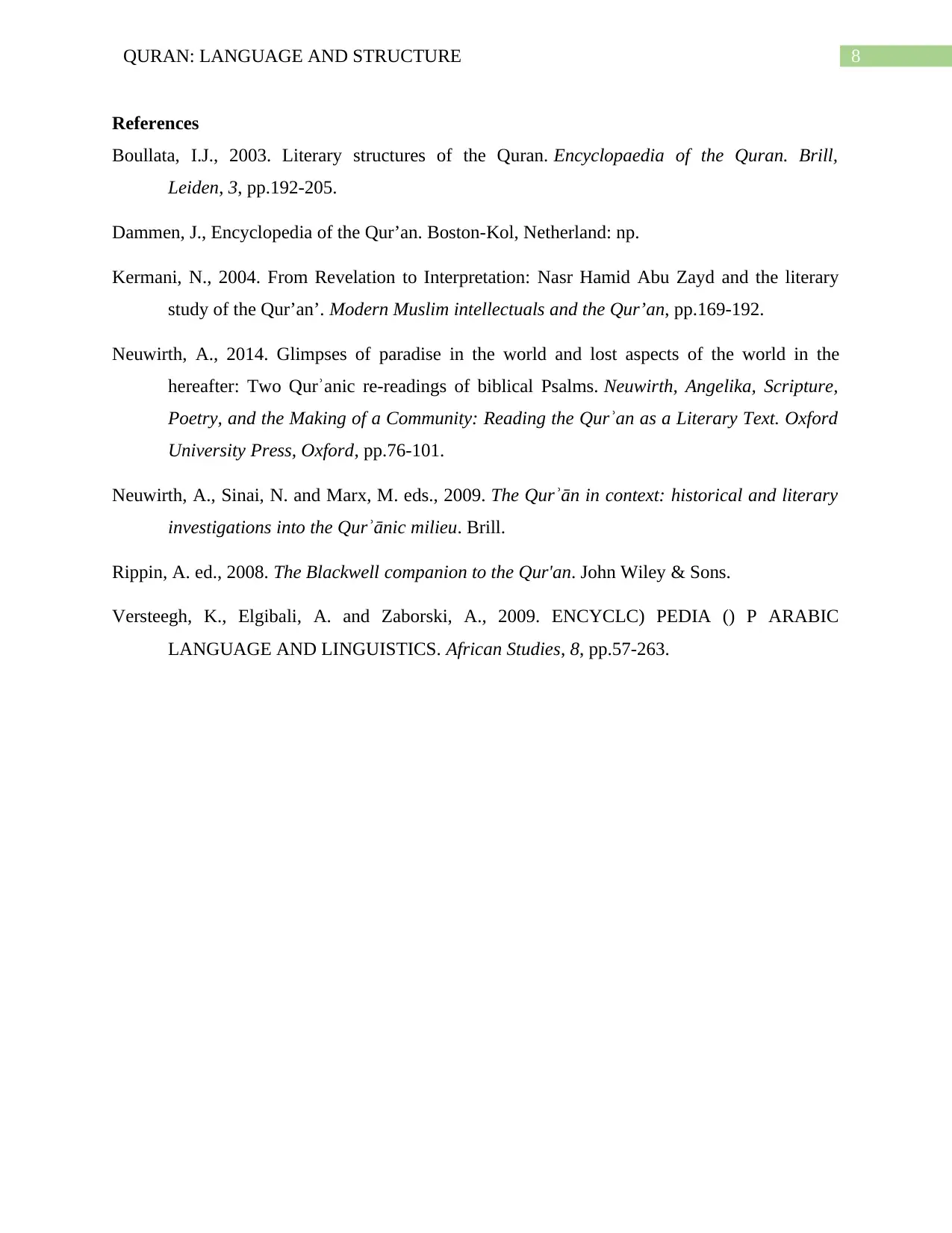
8QURAN: LANGUAGE AND STRUCTURE
References
Boullata, I.J., 2003. Literary structures of the Quran. Encyclopaedia of the Quran. Brill,
Leiden, 3, pp.192-205.
Dammen, J., Encyclopedia of the Qur’an. Boston-Kol, Netherland: np.
Kermani, N., 2004. From Revelation to Interpretation: Nasr Hamid Abu Zayd and the literary
study of the Qur’an’. Modern Muslim intellectuals and the Qur’an, pp.169-192.
Neuwirth, A., 2014. Glimpses of paradise in the world and lost aspects of the world in the
hereafter: Two Qurʾanic re‐readings of biblical Psalms. Neuwirth, Angelika, Scripture,
Poetry, and the Making of a Community: Reading the Qurʾan as a Literary Text. Oxford
University Press, Oxford, pp.76-101.
Neuwirth, A., Sinai, N. and Marx, M. eds., 2009. The Qurʾān in context: historical and literary
investigations into the Qurʾānic milieu. Brill.
Rippin, A. ed., 2008. The Blackwell companion to the Qur'an. John Wiley & Sons.
Versteegh, K., Elgibali, A. and Zaborski, A., 2009. ENCYCLC) PEDIA () P ARABIC
LANGUAGE AND LINGUISTICS. African Studies, 8, pp.57-263.
References
Boullata, I.J., 2003. Literary structures of the Quran. Encyclopaedia of the Quran. Brill,
Leiden, 3, pp.192-205.
Dammen, J., Encyclopedia of the Qur’an. Boston-Kol, Netherland: np.
Kermani, N., 2004. From Revelation to Interpretation: Nasr Hamid Abu Zayd and the literary
study of the Qur’an’. Modern Muslim intellectuals and the Qur’an, pp.169-192.
Neuwirth, A., 2014. Glimpses of paradise in the world and lost aspects of the world in the
hereafter: Two Qurʾanic re‐readings of biblical Psalms. Neuwirth, Angelika, Scripture,
Poetry, and the Making of a Community: Reading the Qurʾan as a Literary Text. Oxford
University Press, Oxford, pp.76-101.
Neuwirth, A., Sinai, N. and Marx, M. eds., 2009. The Qurʾān in context: historical and literary
investigations into the Qurʾānic milieu. Brill.
Rippin, A. ed., 2008. The Blackwell companion to the Qur'an. John Wiley & Sons.
Versteegh, K., Elgibali, A. and Zaborski, A., 2009. ENCYCLC) PEDIA () P ARABIC
LANGUAGE AND LINGUISTICS. African Studies, 8, pp.57-263.
1 out of 9
Your All-in-One AI-Powered Toolkit for Academic Success.
+13062052269
info@desklib.com
Available 24*7 on WhatsApp / Email
![[object Object]](/_next/static/media/star-bottom.7253800d.svg)
Unlock your academic potential
© 2024 | Zucol Services PVT LTD | All rights reserved.